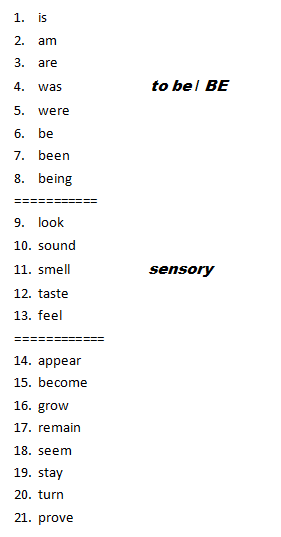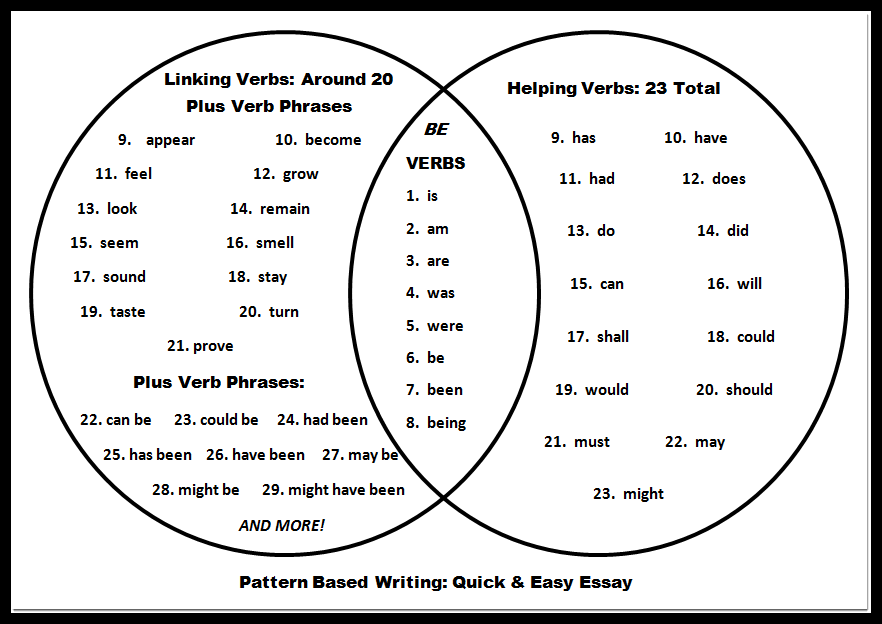Two Version of the Same List:
1. The Venn Diagram (above)
2. The Two-Column Memorization List (below)
The Two-Column Memorization List
The following two-column list is divided up in order to help with easy memorization. Also, notice that the first eight words on both lists are the same exact words.
| Helping Verbs (Also called auxiliary verbs) | Linking Verbs (Also called state of being verbs) |
|---|---|
 The Simplest Fact in all of Grammar: There are just 23 helping verbs. Memorize them. ** Please see the Irregular Verb blog post to understand the verb column system I use for making sense of verb suffixes, verb inflections, and verb tenses. |  Most lists of linking verbs contain around 20 words. However, some lists contain a variety of common verb phrases (helping verb + verb). Here are a few common linking-verb verb phrases: 22. can be 23. could be 24. had been 25. has been 26. have been 27. may be 28. might be 29. might have been 30. should be 31. will be AND MORE! |
Helping Verbs vs. Linking Verbs
Can you tell how a word functions in a sentence just by looking at it? No. Let’s take a look at two sentences:
1. The damaged board fell from the fence. (board = noun)
2. We board the plane at 2 PM. (board = verb)
Not only do these two words have different meanings, but they also function as different parts of speech. This concept is fundamental to understanding linking verbs and helping verbs. Let’s take a look at three sentences:
1. Sue is happy. (is = linking verb)
2. Sue is riding her bike. (is = helping verb)
3. Sue is happy when she is riding her bike. (1st is = linking verb; 2nd is = helping verb)
As the Venn diagram visually illustrates and the Two-Column List clearly indicates, the first eight words on each list are the same words—the eight forms of BE or to be. Although these eight words look alike in a sentence, they do not function the same way. Put simply, when the words are used differently, they are different words.
Helping Verbs: IS, AM, ARE, WAS, WERE, BE, BEEN, BEING
≠
Linking Verbs: IS, AM, ARE, WAS, WERE, BE, BEEN, BEING
Memorize This
- Linking verbs are MAIN VERBS.
- Helping verbs are not MAIN VERBS.
It doesn’t matter how the word looks; it matters how it acts. I teach Grammar Slots. In Grammar Slots, the word is what the slot says it is.
Another Confusing Area: HAVE, HAS, HAD vs. HAVE, HAS, HAD
Helping Verbs: HAVE, HAS, HAD
≠
Irregular Verbs: HAVE, HAS, HAD
Another confusing area of overlap is with HAVE, HAS, HAD. As the helping verb list indicates, HAVE, HAS, HAD are all helping verbs. However, HAVE is also an irregular verb (i.e., irregular main verb) with HAS and HAD serving as inflections. Let’s take a look at three sentences:
1. Sue has a bike. (has = main verb)
2. Sue has been riding her bike. (has = helping verb)
3. Sue has a bike and has been riding it all day. (1st has = main verb; 2nd has = helping verb)
Two Sentences with a One-Letter Difference
Let’s take a look at one final example. Surprisingly, everything in these two sentences is the same except for one letter. But as you can see, that one letter changes how that word acts, which changes everything.
| 1. - Helping Verb = has - Main Verb = broken - Complete Verb or Verb Phrase = has broken | 2. - Linking Verb = was - Main Verb = was |
|||||||
|---|---|---|---|---|---|---|---|---|
| 1. The clock has broken. | 2. The clock was broken. | |||||||
| The | clock | has | broken. | The | clock | was | broken. | |
| article | noun | helping verb | main verb (past participle) | article | noun | main verb (linking verb) | adjective (predicate adjective) |
|





